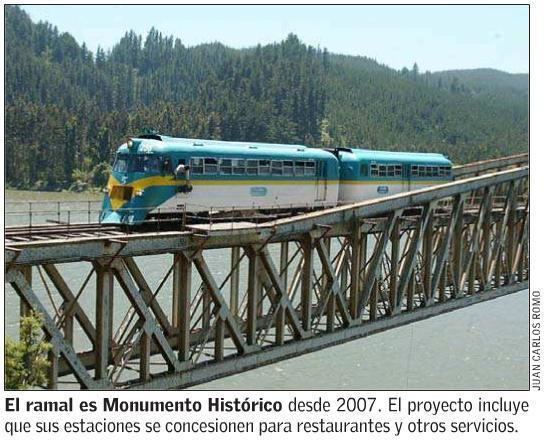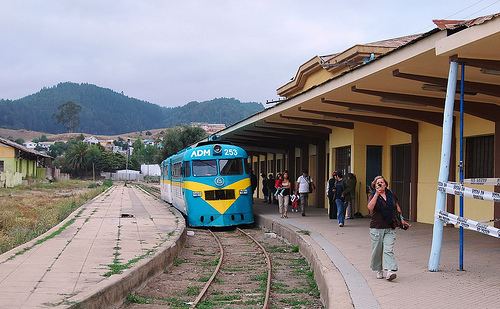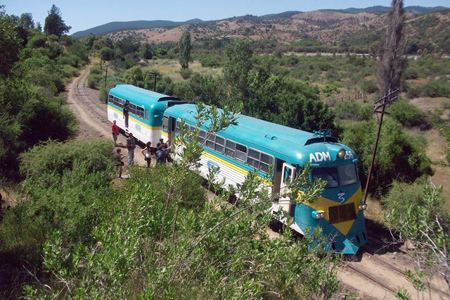 | ||
Ramal talca constituci n en linea maule
The Ramal Talca-Constitución also known as the "Ramal de Maule" is the last remaining narrow gauge ramal train in Chile. Lying in the depths of Chile, the 88 km long journey borders the north bank of the Maule River covering the communes of Talca, Maule, Pencahue and Constitución with Constitución being the last station on the line.The journey offers scenic views of the Andean foothills as well as those of the Pacific Ocean. The line is built strong enough to support a train running at a speed of 50 miles per hour (80 km/h). The railway once the best method of transportation is now facing a major threat of closure due to inactivity and increased preferences of private transport.
Contents
- Ramal talca constituci n en linea maule
- El hist rico ramal talca constituci n
- History
- Old route
- Train technical specifications
- Dependent communities
- Gonzlez Bastas Station
- 2010 88 magnitude earthquake
- References

The line has several features that make it special: It is the last meter gauge dedicated to passenger travel in Chile and runs through an area not served by any other means of ground transportation. Not only that, the bridge of the railway over the Maule River - The Banco de Arena Railway Bridge was designed by the famous architect Gustave Eiffel and was built between 1908 and 1915 by Schneider and Co. On May 25, 2007 the line was declared a National Monument, which meant that it was a valued asset to the country and can not be destroyed.

El hist rico ramal talca constituci n
History
Railway lines first came to the Maule Region when 'The North and South American Company' began construction in 1889. The line opened on August 13, 1892 and the first train ran between Talca and Curtiduría (another commune in Chile). The next part of the proposed line was completed on November 1, 1894 and furthered the line from Curtiduria to Pichamán(yet another commune). In 1902 construction progressed towards the northern bank of the Maule River, opposite Constitución where on a sand bank the first station of Constitución was established. However this station was not easy to reach: people had to cross the river in boats to reach the other side, from where another convoy took them to the Constitución station. This station functioned for 13 years until 1915 when the current Constitución station was opened.

The construction of this line took almost 25 years and was therefore constructed under 7 governments, namely the following:
- Jose Manuel Balmaceda (1886- 1891).
- Jorge Montt Alvarez (1891- 1896).
- Federico Errazuriz Echaurren (1896-1901).
- Germán Riesco (1901-1906).
- Pedro Montt Montt (1906-1910).
- Emiliano Figueroa (Sep 1910 - Dec 1910).
- Ramon Barros Luco (1910- 1915).
- Juan Luis Sanfuentes (Line Opened on Dec 19, 1915)
The line experienced a small tourism boom following a documentary "The Last Ramal" that was aired by several channels around the world and when the Televisión Nacional de Chile made a report on December 2005 named the "Fruit of the Country"
Old route
Originally the train followed the coast in Constitución to the so-called "Sea Baths" (abandoned now), which was a popular tourist resort where people since Victorian times had come to enjoy. Later another stop was added, just prior to the station for the pulp mill Celco. However quite intriguingly in order to get to the Celco plant, trains had to travel through the streets of Constitución. This created a lot of problems and was banned by the Municipality in the early 1970s, though trains continued to function even in 1990's against municipality orders.
Train technical specifications
Dependent communities
A vast majority of villages which are connected by the Ramal Talca-Constitución line, are not connected to the main cities/communes via alternative transport methods (on an average they are separated by 35 kilometers from the road that links the cities like Talca and Curepto). As a result, the Ministry of Transport and Telecommunications of Chile requested tenders for a transportation system that could connect these remote locations. Empresa de los Ferrocarriles del Estado (the company that now manages the Raml-Talca Constitución line) won the tender. As a result, Empresa de los Ferrocarriles del Estado maintained a regular service in order to reach out to thousands of local inhabitants, therefore locals have an explicit priority on the line over tourists or other users.
- Talca: It is the home station of the train where every day the trains start at 7:30 and 16:45 (Chilean time).
- Colín: Located at 12 km from Talca station its name was derived from the bird - "Colines" that once abounded here.
- Rauquén: Today works only as whereabouts, located ahead of the bridge that crosses the Rio Claro.
- Corinto: Formerly called 'Pocoa' it is located at 27 km from Talca and is named after a Greek businessman. A church is in this area is a significant landmark here and Dec 8 each year has a great pomp and show due to the celebration of the Immaculate Conception.
- El Morro: It got its name from Morro de Arica which is located in a very similar area. It lies near the mouth of the River Light and River Loncomilla.
- Curtiduría: The train briefly stops here. The first ever train on this line ran between this station and Talca.
- Los Llocos: This station lies at a distance of 36 km from Talca and lies inside a village of the same name.
- Tricahue: Lies at a distance of 38 km from Talca, in what once was a Monastery.
- El Peumo: This station lying ahead of Tricahue is 41 km away from Talca.
- González Bastías: This is the station is the midpoint being located at 44 km from both Talca and Constitution. It was previously known as Infiernillo.
- Toconey: Located at 48 km from Talca it was previously called San Antonio and then Tanhuao. It is one of the busiest stations on the Ramal.
- Pichamán Oriente: Lying at 50.5 km from Talca.
- Pichamán: The name literally means "little condor." It located at 52 km from Talca.
- Los Romeros: It is one of the busiest stations and lies at 55 km from Talca.
- Los Maquis: At 57.5 km from Talca it lies approximately 3 km ahead of Los Romeros.
- Forel: Located at 62 km from Talca it owes its current name to Swiss biologist François-Alphonse Forel who lived here for several years.
- Huinganes: Located at 68 km from Talca it is one of the best preserved stations. The station was named after the shrub Huingan that abounds here.
- Los Digüeñes: This station being the 5th from last, lies after the Huinganes station.
- Maquehua: It is located at 74 km from Talca and is the 4th last station.
- Astillero: It is located at 78 km from Talca and is the 3rd last station.
- Banco de Arena: Lying at 83 km from Talca it was the terminus of the branch line until 1912.
- Constitución: It is currently the terminus of Ramal Talca-Constitución line. Trains depart from here at the same time as from Talca
González Bastías Station
González Bastías is a small town which marks the halfway point at 44 km, and an obligatory stop for the trains in both directions, as there is only one track, and this is where they pass each other. During a stop-over here people usually buy rescoldo- a hearty bread with pork sausage and hard boiled eggs. This place is also a storehouse for abandoned rail cars here. González Bastías was originally called Infiernillo (little hell) for the suffocating summer heat and the dismal winter isolation. The town was later renamed in honor of a local poet, which is why the station is also known as Estación Poeta.
2010 8.8 magnitude earthquake
Due to the earthquake that hit the area in February 2010, the branch was seriously damaged. The scourge of the tsunami also wrecked Constitución Station. The national media reported of the ghost towns created whilst the line was out of service, due to the fact that the towns served by the line are completely dependent upon it. In normal year 90,000 people use the service in order to travel to local towns for work, leisure or commerce. After 9 months without service the line was formally reopened by president Sebastián Piñera fulfilling an election promise. Despite being seriously damaged in the earthquake and tsunami the ramal was repared relatively quickly and now continues to operate.
